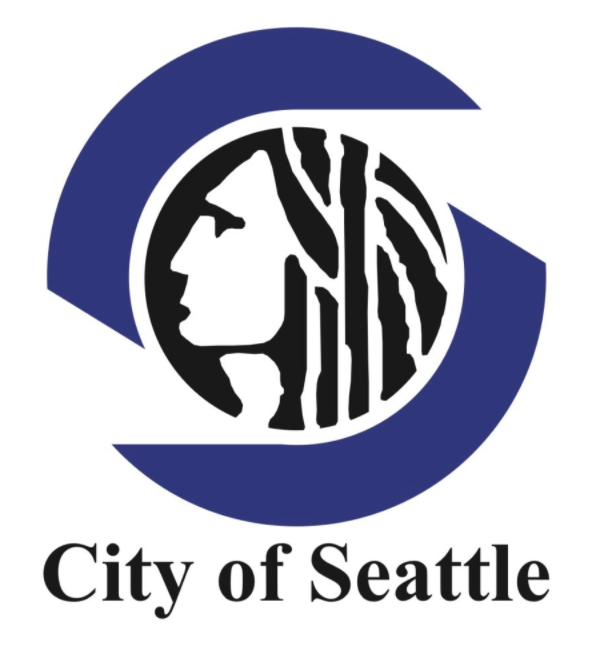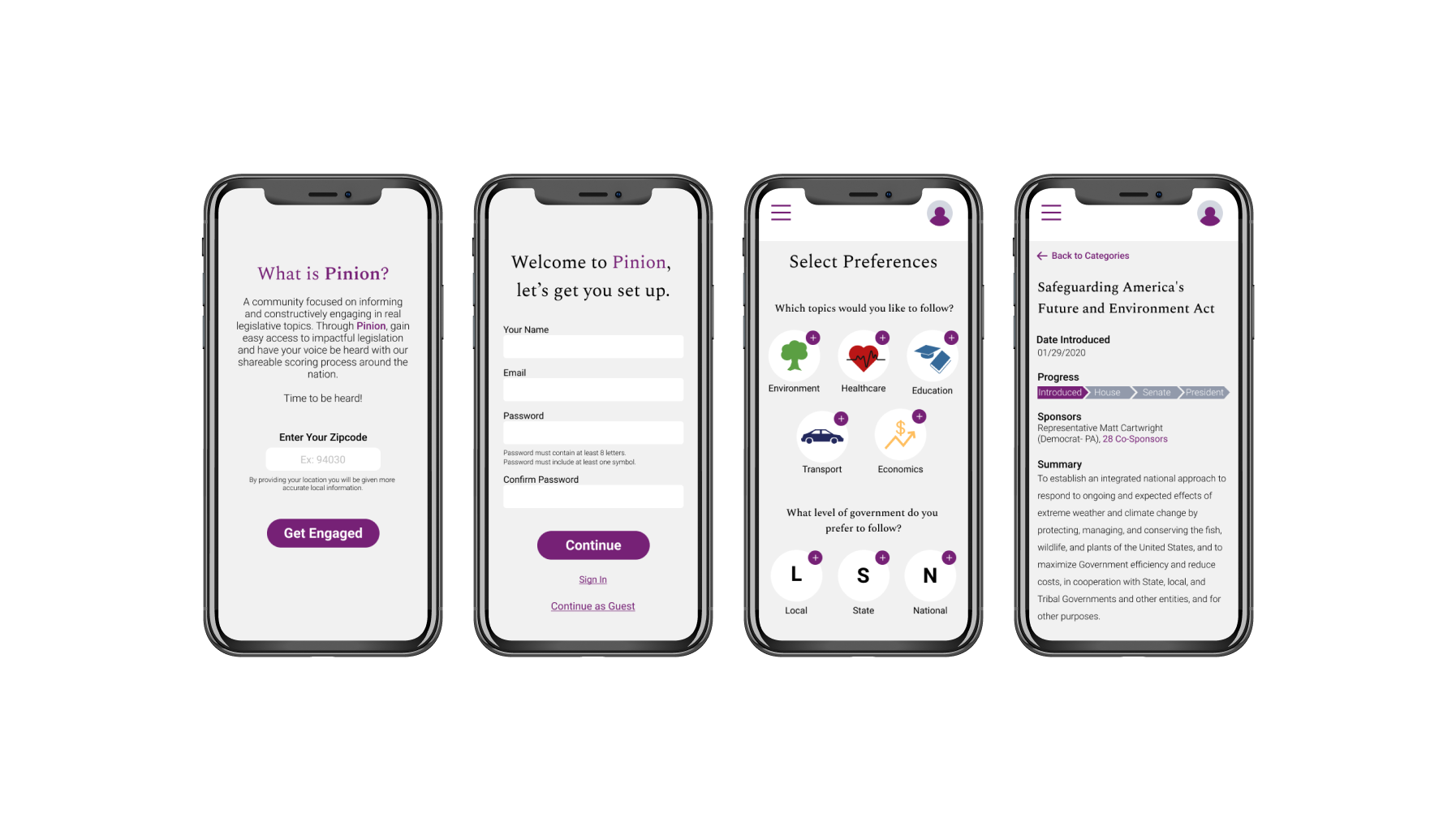
Pinion
Political Engagement Site
Project Details
Timeline 3-week sprint
Platform Responsive Web
Contributing Members Aleia Hayag, Blake Payne
My Contributions Synthesis Lead, User Interviews & Synthesis, Persona, Competitive Analysis, User Testing, Assisted Design Lead
Tools Figma, Miro, Zoom, Pen & Paper
About Pinion
Pinion vision is “for Pinion to be THE global democracy platform, where every significant piece of legislation can benefit from open, public engagement, and intelligent discussion that fosters civic participation and political progress.” - PinionVote.com
Design Challenge
To create a platform where people can easily find and vote on legislation.
Exploring the Problem
The political climate today is more active than it has been for people all over the united states. To fully get a grasp as to what we were going to be accomplishing we had meetings with Stakeholders to determine our focus. They provided us with research from previous teams and a look into their theoretical MVP. After looking through the data, we found we would have to start from scratch to find if the assumptions made about the political sphere were fact still today in this changing climate, and to narrow down the feature list to what users needed.
C&C
Taking into account what our client was looking for I found examples of different types of political environments online from political applications, government sites, potential direct competitors and even polling sites. This allowed us to see the breadth of information people are provided and to understand the current market and keep us aware of how much was out there and the importance of narrowing our focus to complete our task within the timeframe allotted.
Interviews
This lead us into interviews. My team and I set out to explore the current issues surrounding how people interact with and understand political information and legislation. I looked for people who had an interest in learning more about politics or legislation. I then asked our interviewees questions about how they received information political or not, and what their level of engagement in politics was. Key insights I received were:
I care about topics that align with my personal beliefs
I don’t feel comfortable engaging in public conversations regarding politics
I find that doing my own research is important to ensure that I understand and trust the information that I’m consuming.
I worry that my opinions might be judged if I share them in a public space.
I become emotionally discontented with today’s politics and news.
I have a difficult time finding relevant and accurate information online.
Quote from one of our interviewees that summarizes how many of our interviewees felt:
“I want to be informed before getting involved.” – anonymous interviewee
Persona
I compiled all the data from these users and came up with our Persona, Mimi. As I am focused on designing around our users’ needs and goals, I use Personas to see who those users are and what they need. Mimi served as that main user. Mimi is the type of person who absorbs news several times a day, with a newspaper in the morning, checking social media throughout the day, and listening to podcasts after work. She follows politics, but has difficulty finding local news sources and trustworthy sources at that. She avoids posting about politics for fear of confrontation and judgement.
I then structured statements using interview insights and our Persona, Mimi. It was important for me to refer back to these problem statements to constantly remind myself during ideating solutions.
Problem Statements:
A community member who feels disconnected from the political sphere needs a way to find unbiased, verified information on legislation but finds it difficult because there is an overwhelming number of sources with unknown levels of reliability and bias.
A community member who feels the political space is confrontational needs a way to voice their concerns on national topics but does not want to be publicly identified because they worry about judgement from people outside of their close network.
A community member who feels passionately about important and personally relevant causes, needs a way to sift through all topics, because the information that is available can be overwhelming and difficult to find.
An active voter who feels removed from important local legislation needs a way to procure information regarding local government, but does not because their trusted news sources do not cover in-depth on local topics.
Problems revolve around: information, bias, difficulty and local sources.
Solving the Problem
To solve these problems, I looked to find how we might provide an easy way for community members to find reliable, unbiased sources. I thought about how we could reduce the number of topics a community member would need to sift through, how we could eliminate confrontation, and how we could engage a voter in local legislation.
To make sure our team was in alignment with ourselves, our client and Mimi, I participated in a feature prioritization workshop where we ideated on everything imaginable, narrowing it down to 4 key categories: Must have, Should have, Could have and Won’t have.
To qualify as must-have features they needed to address concerns for both our client and our users, and be feasible to build within the scope of time and money constraints.
Must- have features
Clear categories & filters: so users wouldn’t have to sift through large amounts of topics on their own.
Unbiased information summaries: to ensure that Pinion is providing its users verified content and giving users direct access to credible sources.
Registration for new users: to create the wall of privacy that users are seeking when partaking in engagement.
Ability to score content: the bread and butter of Pinions brand, and serves as a great way for users to share their opinion in an impartial fashion.
We sketched, narrowed ideas down and came out with a Medium fidelity wireframe.
Wireframes
We turned to our users to get a better understanding of how they would navigate our website and find areas where we could improve the design through testing. Our research and ideas came together in these grayscale wireframes.
Testing the Solution
Usability Test
The landing page with the location, was too vague for users and after two iterations we landed on a new more specific title with an input box that clearly represented the final information with a confirmation cue, so users didn’t second guess their input.
When users got to the sign-up process, they didn’t feel their information was secure, especially since they were sharing opinion they didn’t want to risk having their personal information exposed. Users were confused when there was no second step to confirm their password and wanted a clear indication of what was required when making the password.
On the “Score your legislation” page we had kept it simple with only Scoring of “support” and “importance” along with anonymity for community members uncomfortable with sharing to Pinion. In our usability tests, users found that they wanted to explain their reasoning for what they chose.
During usability test we found that while tags were of two different colors it wasn’t clear which ones were the selected ones and which ones were not until after the users clicked on one.
Final Product
With our changes made, we created our high-fidelity wireframes for our prototype.
Next Steps
There is much more to be explored and prioritized as Pinion’s platform continues to expand. Stakeholders planned on many more capabilities and we prioritized and balanced with what users wanted, stakeholders plan and time constraints. Moving forward, Pinion can apply our process to build out Pinions sharing, and the scoring process- which each would have required their own set of research methods. Pinion can also explore mobile responsive web further than we could given time constraints.
Lessons Learned
Because Pinion is just starting out, shareholders had many plans and ideas that they wanted to include. They were looking to expand upon their MVP, which ended up having much more than would be included in an MVP. When I saw the MVP, I knew we would really need to cut down and focus on what their main goals were, and find what users wanted from there. So I asked questions that clarified Pinion’s goals, which led to the creation of a relevant design.
I anticipate this happening again in the future, with shareholders wanting to implement many features, and I will do my best to evaluate the needs at that point in time with time constraints, money and quality in mind to determine what is feasible in conjunction with what users need.

























